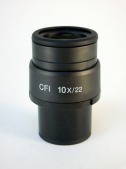
Magnification: Eyepieces come in different magnifications. The most commonly used is the 10x magnification. The majority of pre-configured microscopes come with 10x eyepieces. The major manufacturers such as Nikon, Olympus, and Leica make eyepieces in 15x and 20x for increased magnification. The trade off for that the higher the magnification, is a smaller the field of view, and the more costly the eyepiece.
When calculating total magnification, we multiply the power of the eyepiece by the power of the objective. (and any intermediate or auxiliary lenses.) In the Nikon CFI 10x/22 eyepiece pictured above, the magnification is 10x. To determine the total magnification used with a 40x objective, we simply multiply the 10x by the 40x to get a total magnification of 400 times under a 40x objective. If you don’t specifically need an increase in magnification, then stick with 10x eyepieces and the wider field of view at the more economical price point.
Field of View: Eyepieces use a “Field of View” number often given in millimeters to measure the complete field of view when used in conjunction with the different objectives on a microscope. Eyepieces typically come sized with 18mm, 20mm, and 22mm field of view numbers. The field of view should always be in concert with the field number of the objectives used. If you us an eyepiece with a 22mm field of view and an objective with a 20mm outside field number you will get a halo effect when looking through the microscope at low power. It is highly recommended that you consult an authorized microscope representative to make sure the eyepieces you are buying are matched correctly to your corresponding objectives. The bigger the field number, the larger the field of view. To calculate field of view you can visit the chart in the link.
Physical Fit: The eyepiece must physically fit into the eyepiece tube. Not all 10x/22mm eyepieces are the same. The eyepiece in the picture above fits a Nikon Ci-L microscope head. This eyepiece is proprietary to Nikon’s heads because there are little notches to keep the eyepiece from spinning when using the diopter.
Eyepiece Micrometer: Lastly, the other number that comes into play when looking at an eyepiece is the micrometer size. Most high quality eyepieces accept micrometers. This micrometer size typically ranges between 18mm and 27mm. This size is typically only available from the manufacturer. The round glass eyepiece micrometer (sometimes referred to as a reticle) is installed through the bottom of the eyepiece and is held in place with a retaining ring. Micrometers are available in a wide variety of types and sizes for counting and measuring.
Closing Recommendation: My advice would be to size your eyepieces according to the manufacturer’s recommendation per the particular model microscope you are using. Interchanging eyepieces can reduce optical quality. Consult a reputable microscope dealer for guidance, now that you have a basic overview of what to look for in an eyepiece.